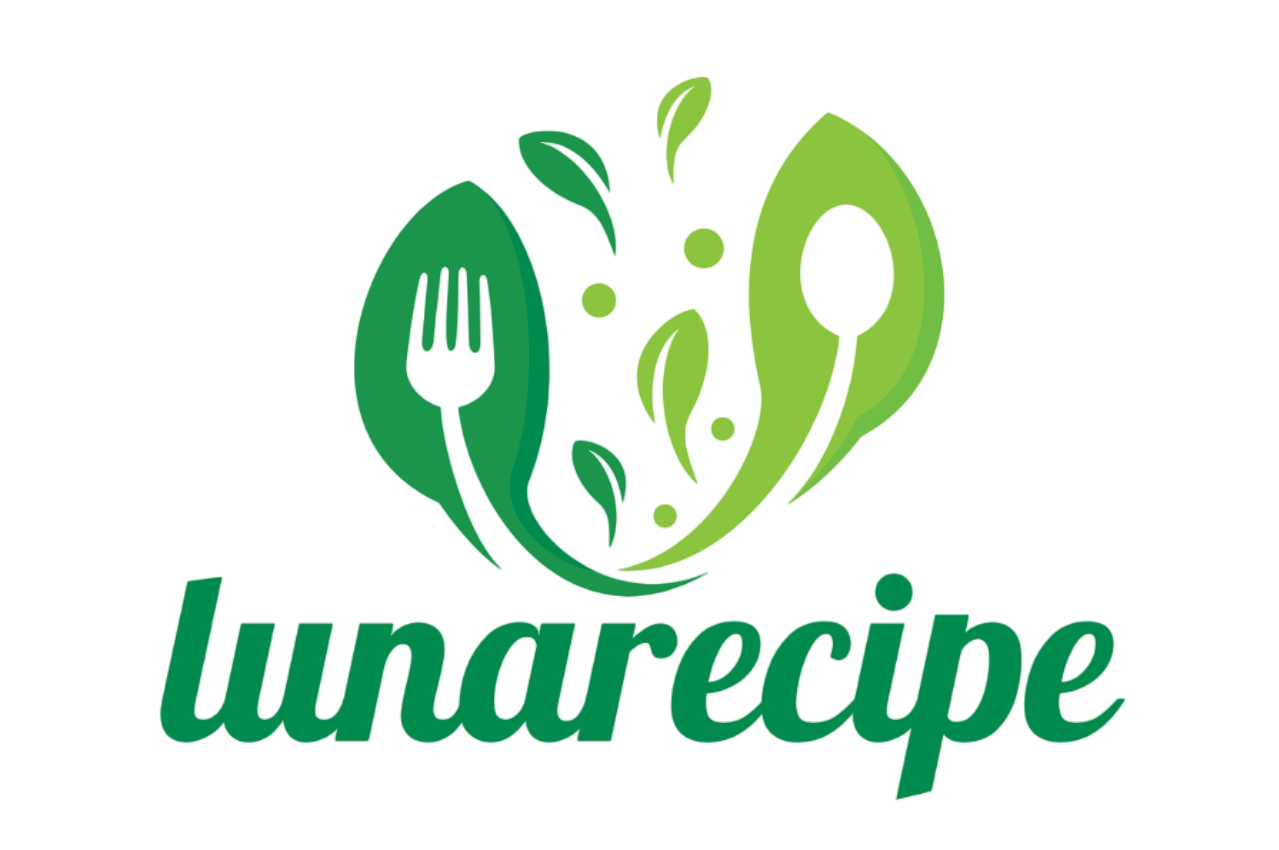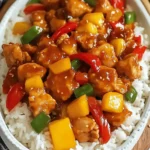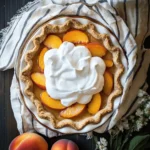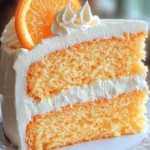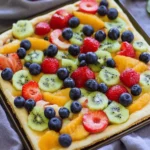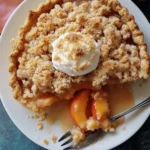This Classic Baked Cheesecake is the dessert you never knew you needed but will now never want to go without. Smooth and indulgent without being overly rich, it’s a perfect balance of creamy filling and golden biscuit crust, elevated with a touch of lemon zest and topped with fresh berries for a burst of color and flavor.
Whether you’re hosting a holiday dinner or looking to impress at a weekend brunch, this cheesecake delivers every single time. It’s an approachable yet show-stopping dessert that proves you don’t need complicated methods (or a water bath!) to achieve cheesecake greatness.
Full Recipe:
Crust:
-
200g / 7 oz Marie crackers (or 28 graham cracker squares)
-
120g / 8 tbsp unsalted butter, melted
Filling:
-
500g (1 lb) cream cheese, softened
-
2 tbsp all-purpose flour
-
1 tsp vanilla extract
-
1/2 cup full-fat sour cream
-
1 1/2 cups caster (superfine) sugar
-
Zest of 1 lemon
-
3 large eggs, at room temperature
Toppings:
-
Strawberries, blueberries, raspberries
-
Icing sugar, for dusting
Directions:
-
Preheat oven to 160°C/320°F (140°C fan).
-
Prepare a 20cm/8″ springform pan: Invert the base, lightly butter it, and place a square of parchment paper over it. Lock the pan and line the side with butter and baking paper.
-
To make the crust: Break up biscuits and blitz in a food processor until fine. Add melted butter and blitz until it looks like wet sand.
-
Press the crust into the base and up the sides of the prepared pan using a measuring cup. Set aside.
-
For the filling: Beat cream cheese until smooth (30 seconds on medium-high).
-
Add flour and beat until just combined.
-
Add vanilla, sour cream, sugar, and lemon zest; beat until just combined (10–15 seconds).
-
Add eggs one at a time, beating just until incorporated (10 seconds each). Do not overmix.
-
Pour the filling into the crust and bake for 55 minutes. The top should be lightly golden, flat, and slightly jiggly in the center.
-
Cool the cheesecake in the oven with the door ajar for 20 minutes. Refrigerate in the pan for 4+ hours.
-
Remove springform sides, slide off the pan base using the paper overhang, and transfer to a serving plate.
-
Top with fresh berries and dust with icing sugar before serving.
Prep Time: 20 minutes | Cooking Time: 55 minutes | Total Time: 1 hour 15 minutes
Kcal: 408 kcal | Servings: 12 servings
The Allure of a Classic Baked Cheesecake
Few desserts can claim the universal appeal that a classic baked cheesecake enjoys. Creamy, tangy, and decadent, it strikes a delicate balance between richness and lightness that makes it endlessly enjoyable. Whether served plain or adorned with vibrant berries, a good cheesecake never goes out of style.
Unlike its no-bake counterparts or more flamboyant variations like Japanese cotton cheesecakes and Basque burnt cheesecakes, this classic baked version offers a refined texture and timeless flavor profile. It’s soft without being fluffy, creamy without being overly dense, and sweet without becoming cloying. It’s a crowd-pleaser that fits in at both casual brunches and formal dinners alike.
Why Baked Cheesecake Is Easier Than You Think
There’s a common misconception that cheesecake is difficult or intimidating to make. But the truth is, a baked cheesecake—especially when prepared with a few key tips—is surprisingly straightforward. One of the major perks is that it doesn’t rely on rising agents like baking powder or baking soda, which means there’s less risk of collapse or uneven texture. Unlike sponge cakes that can sink, split, or dry out, a cheesecake is more forgiving.
Another huge advantage? You don’t even need a water bath to get the perfect texture. Many traditional recipes call for one, but modern tweaks (like baking at a low, consistent temperature and letting it cool slowly in the oven) remove that hassle without sacrificing quality.
The Anatomy of a Perfect Cheesecake
At its core, a cheesecake consists of two main elements: a crumbly biscuit base and a rich, custard-like filling.
The base is often made from crushed biscuits like graham crackers, digestives, or Marie cookies, combined with melted butter. The crust should be pressed firmly into the pan—not just on the bottom, but also up the sides. This technique ensures a strong structure that holds the filling without crumbling or collapsing, while also providing a lovely textural contrast to the creaminess of the custard.
The filling, made primarily with cream cheese, sour cream, sugar, eggs, and a hint of vanilla or citrus zest, should be smooth and luscious. Over-mixing is the enemy here—it incorporates too much air, which can lead to cracks or a puffed-up, uneven surface. The goal is to keep the mixture as silky as possible while avoiding aeration.
Texture and Flavor: What Sets This Cheesecake Apart
This baked cheesecake is a “middle-of-the-road” option in the best way possible. It’s not as dense and heavy as a New York-style cheesecake, but it also isn’t light to the point of being mousse-like. Instead, it offers a smooth, melt-in-your-mouth consistency that feels luxurious but not overwhelming.
A touch of lemon zest adds a subtle brightness that balances the richness of the cream cheese and the sweetness of the sugar. The sour cream in the batter adds depth and tang, rounding out the flavor and contributing to that ultra-smooth finish.
The finished cheesecake has a golden surface that’s slightly firm to the touch and a center that should gently jiggle when nudged. After a good chill in the refrigerator, the texture firms up beautifully while still retaining that luscious, creamy interior.
The Role of Simplicity
Part of what makes this cheesecake so appealing is its simplicity. There’s no need for elaborate techniques or specialty equipment. A basic springform pan, a mixer (hand or stand), and a bit of patience during the chilling process are really all you need.
This is a dessert that celebrates minimalism: a handful of quality ingredients treated with care to produce something unforgettable. The focus is on flavor and texture rather than presentation gimmicks, though you can certainly dress it up with seasonal fruit, coulis, or even edible flowers if the occasion calls for it.
Customizing Your Cheesecake
While this recipe is stellar as-is, it also serves as a fantastic base for experimentation. You can infuse the filling with citrus (like lime or orange zest), add swirls of caramel or chocolate, or even fold in fruit like blueberries or raspberries.
The topping is another area ripe for creativity. Fresh berries are a classic choice, but other options include:
-
A drizzle of homemade berry compote
-
Whipped cream and a dusting of cocoa
-
Sliced mangoes or peaches for a tropical twist
-
A shiny glaze of apricot jam for elegance
Even the crust can be customized. Swap graham crackers with chocolate cookies, digestive biscuits, or even nuts and seeds if you’re aiming for a gluten-free version. Just make sure the crumb is fine and the mixture holds together well when pressed.
Serving Suggestions and Storage Tips
Baked cheesecake is best served chilled, ideally after resting for at least four hours in the fridge—though overnight is even better. This gives the filling time to set completely and develop its full flavor.
Use a warm knife to slice for clean, sharp edges. Run the knife under hot water and wipe it between cuts to avoid smudging.
Leftover cheesecake should be stored in the refrigerator, covered tightly to prevent it from absorbing odors. It will keep well for 4–5 days. Cheesecake also freezes surprisingly well—just wrap slices individually and thaw overnight in the fridge when ready to eat.
The Do’s and Don’ts of Cheesecake Success
Do:
-
Use room temperature ingredients for a smooth, lump-free batter.
-
Line the pan with parchment paper and invert the base for easy transfer.
-
Chill the cheesecake thoroughly before serving.
Don’t:
Advertisement
-
Over-beat the batter—air bubbles are the enemy of a flawless top.
-
Skip the cooling step in the oven; this helps prevent cracks.
-
Remove the cheesecake from the pan before it has fully chilled and set.
The Emotional Appeal of Cheesecake
Beyond technique and flavor, cheesecake carries a nostalgic, emotional weight for many. It’s a dessert often associated with special occasions—birthdays, holidays, anniversaries—and is a universal symbol of celebration and comfort.
Because it’s rich, a little goes a long way, and each bite feels like a treat. It’s also the kind of dessert that people remember. Few things generate recipe requests like a perfectly baked cheesecake brought to a dinner party.
Conclusion: A Timeless Classic Worth Mastering
In an ever-evolving dessert landscape filled with trends and novelties, the classic baked cheesecake remains a beacon of elegance and reliability. It’s a dessert that doesn’t need reinvention—just care and attention to detail.
Whether you’re baking for your family, impressing guests, or simply treating yourself to a weekend indulgence, this cheesecake will never let you down. It’s a reminder that sometimes, the best recipes are the ones that stay closest to tradition—simple, sincere, and absolutely delicious.
Master it once, and you’ll have a dessert you can rely on for life.
